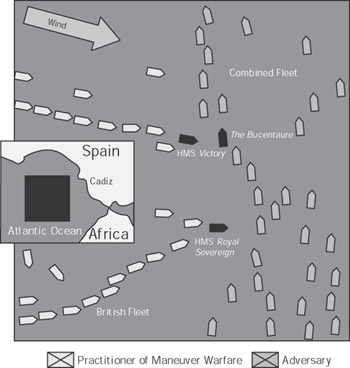Nelson at Trafalgar
At the Battle of Trafalgar in 1805, British admiral Lord Horatio Nelson crushed the Combined French-Spanish fleet off the coast of Spain by focusing his combat power at two critical points in French admiral Pierre-Charles Villeneuve s line.
Nelson was outnumbered and outgunned thirty-three ships to twenty-seven but possessed key advantages in seamanship and short-range gunnery. Accordingly, he devised a plan to breach the combined fleet s line and engage at close quarters , where his forces held the upper hand. Defying conventional naval tactics, which would have had the opposing fleets line up parallel and bombard each other s broadsides, Nelson divided his smaller force into two columns and attacked in a perpendicular direction, which brought overwhelming combat power to bear where it mattered most.

Figure 7.2: Nelson at Trafalgar, 1805
Owing to an advance warning he received from his frigates, fast-moving scout ships, Nelson occupied an advantaged position ”upwind [9] and to the west relative to his opponent ”in the waters outside the Straits of Gibraltar on the morning of October 21. Upon spotting Nelson s fleet, Villeneuve ordered his fleet, which had been sailing in a southeasterly direction, to change course 180 degrees, re-form its line, and head back to Cadiz in a northwesterly direction. Because of light winds, this was a jumbled process, and Villeneuve s line bowed in the center.
Using flags to signal the now-famous guidance England expects that every man will do his duty, Nelson unleashed his attack. [10] Aboard the HMS Victory , he led one of the British columns toward Villeneuve s Bucentaure , the tenth ship in the combined fleet line. To the south of Nelson, Admiral Cuthbert Collingwood, aboard the HMS Royal Sovereign , led the second column toward the twelfth ship in the combined fleet line.
During this final approach the British were most vulnerable. Nelson s ships were fully exposed to the broadsides of the combined fleet, and their own side-mounted, outward- facing cannons were limited in their ability to fire forward. Nelson had to take this risk to focus his limited combat power, breach the combined fleet s line, and capitalize on his sailors superior seamanship and gunnery skills. Fortunately, both British columns were sailing with the wind.
In the final stages of the approach the lead British ships began taking heavy fire. Nevertheless, they smashed through the combined fleet s line and inflicted heavy damage. Victory devastated the decks of the Bucentaure with a large sixty-eight- pound gun that fired grapeshot at point-blank range. And the remainder of Nelson s column effectively isolated the combined fleet s vanguard ”the first nine ships in the line ”from the conflict. Collingwood s column smashed into the second point in the combined fleet s line with a wedge -shaped formation and attacked the Spanish and French ships from the rear.
After five hours of intense fighting and heavy casualties on both sides, fifteen combined fleet ships were captured, four were destroyed completely, and fourteen were fleeing. No British ships had been lost; although many had been damaged. Villeneuve had been captured, but Nelson had suffered a mortal wound ”a rifle shot from a sniper ”in his moment of triumph. Thank God I have done my duty were his last words. [11] And do his duty he did: Nelson s victory asserted the British navy as the preeminent sea power in the 1800s and contained Napol on s campaign within continental Europe.
Leadership Lessons
Nelson knew that he would have little chance of victory if he were to line up parallel to the numerically superior combined fleet and engage in a contest of firepower. Accordingly, he willingly exposed a vulnerability and used focus to break Villeneuve s line, thereby changing the nature of the engagement to a contest of seamanship and close-range gunnery, areas in which the British were far superior. His unorthodox yet brilliant approach removed the first nine ships in the combined fleet s line from the battle and positioned his forces to attack the Spanish and French ships from the rear, where they were weakest.
[9] In an era of wind- and sail- powered vessels, the forces upwind had an advantage in forcing combat at the time and place of their choice.
[10] Nelson s original signal was to have been England confides that every man will do his duty, but confides was not in the telegraphic vocabulary. Nelson thus agreed to substitute expects , which changed the meaning of the message and caused confusion among British sailors, who felt strongly that they would always do their duty and should not have to be asked.
[11] www.andalucia.com/history/trafalgar.htm.
EAN: 2147483647
Pages: 145